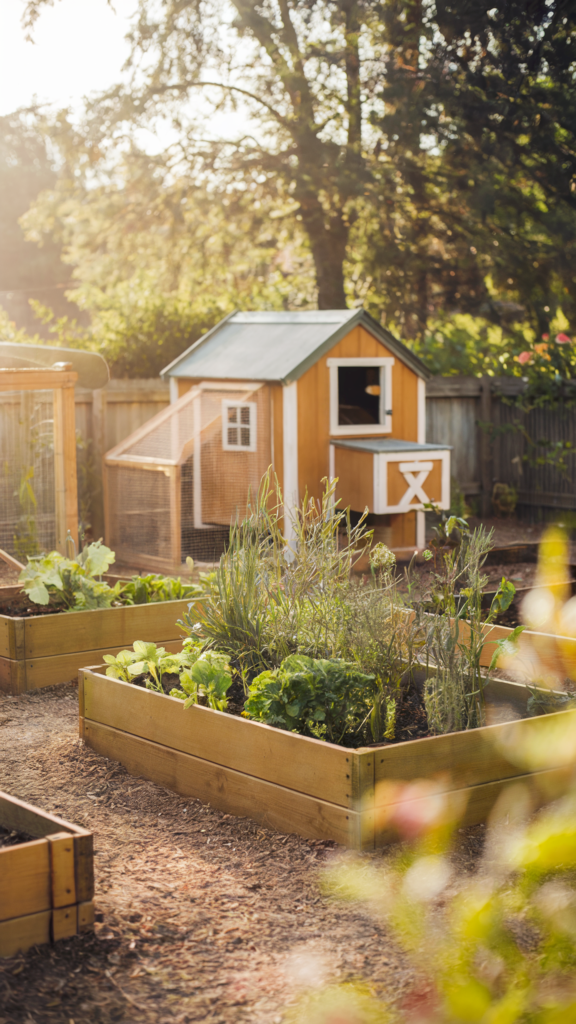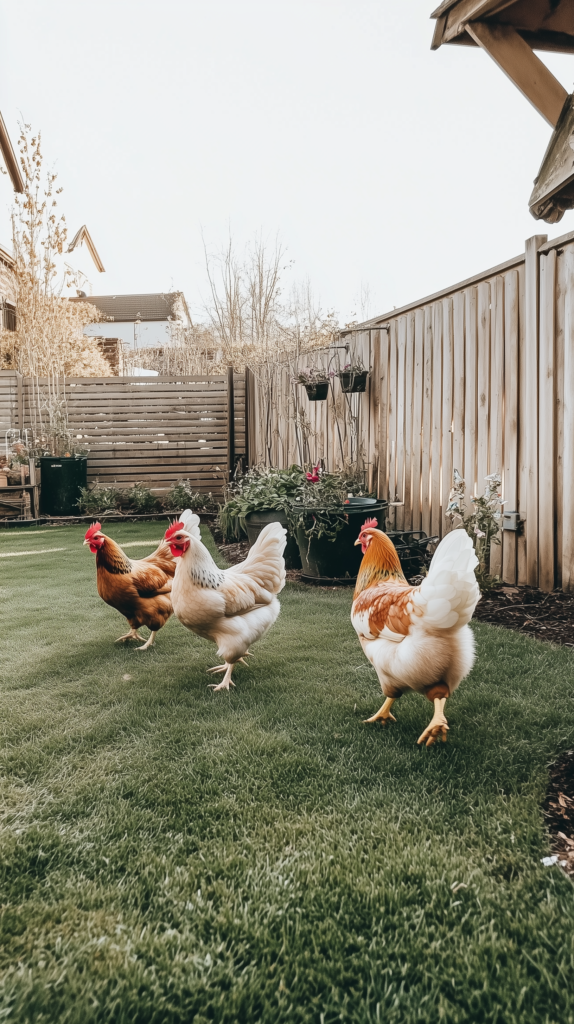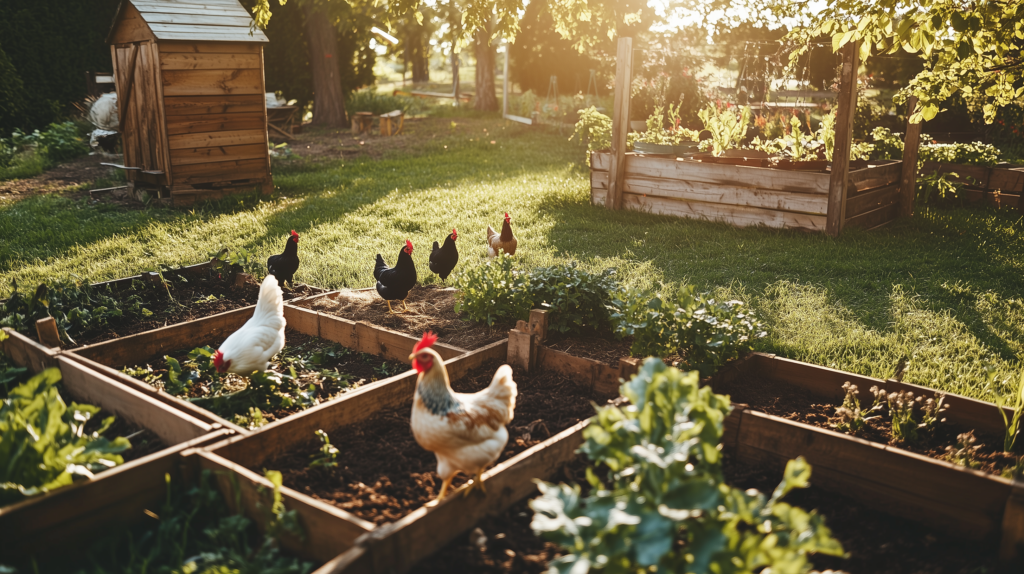This post may contain affiliate links, including those from Amazon Associates. If you make a purchase through these links, I may earn a commission at no additional cost to you. Learn more about our affiliate policy.
I’m a bit of an egg snob.
There’s something so satisfying about knowing exactly where your food comes from, with no long supply chains, no questionable practices, just clean, nourishing eggs straight from your own flock.
Raising chickens is one of the backyard homesteading projects that is a step toward a more sovereign lifestyle. Keeping your own chickens frees you from reliance on the mechanized food system and reconnects you with nature.

Taking on the task of raising chickens can feel overwhelming, but in this guide I’ll walk you through 8 simple steps to raise happy, healthy chickens. Together, we’ll explore everything you need to create a thriving flock that brings you closer to a life of vitality and independence!
Why Raising Chickens is a Great Idea
Before we get started, let’s touch in with how caring for chickens contributes to an urban homesteading lifestyle. The most obvious perk is the fresh eggs. Those golden yolks that are packed with goodness for you and your family.
Farm-fresh eggs are packed with nutrients and flavor that store-bought eggs just can’t match. They’re richer in things our body needs like vitamin A and E, higher in omega-3s, and free from the antibiotics often found in commercial operations.

Plus, knowing exactly where your food comes from provides an unmatched sense of sovereignty and peace of mind.
Chickens are also natural pest controllers, happily scratching around to reduce insects like ticks and flies in your yard. They play a vital role in sustainability by creating nutrient-rich compost from their droppings, perfect for feeding your garden soil.
With chickens as part of your backyard homestead, you’ll notice a beautiful cycle of life that feels deeply connected to nature.
And let’s not forget, raising chickens can be incredibly rewarding. Whether you’re bonding over the experience as a family or simply enjoying the quiet routine of caring for your flock, chickens have a way of enriching our daily lives.
They remind us to slow down, observe, and appreciate the simpler things. Thin of them as a little flock of zen.
If you’re worried about things like space, time, or effort, let me reassure you: raising chickens doesn’t have to be complicated. Even with a small backyard, you can create a thriving environment for your flock with just a bit of planning. Let’s explore how you can make it happen!
Step 1: Research Local Regulations and Permits
Before diving into backyard chicken keeping, it’s important to understand the rules in your area. Local regulations often dictate how many chickens you can keep, where you can place your coop, and even noise levels.
Some neighborhoods or homeowner associations (HOAs) may have specific guidelines or outright restrictions on backyard flocks, so it’s crucial to do your homework before getting started.
Here’s how to research and prepare:
Check Local Zoning Laws
Visit your city or county’s website, animal control office, or zoning department for zoning information. Look for details on:
- Allowed flock sizes.
- Minimum distances for coop placement from property lines or structures.
- Noise restrictions, especially regarding roosters.
Review HOA Rules (if applicable)
If you’re part of a homeowner association, ask for their policies on backyard chickens. Rules can vary widely between neighborhoods.
Talk to Your Neighbors
In urban or suburban areas, consider your neighbors.
- Let them know your plans and address common concerns like noise or odor.
- Share your intention to maintain a clean, well-kept coop.
Step 2: Choose the Right Breed for Your Backyard

Selecting the right chicken breed is key to creating a happy and thriving flock that fits your family’s lifestyle and environment. Some breeds are easier to care for, making them perfect for beginners, while others are better suited for specific climates or goals.
For beginners in more urban spaces, it’s best to stick with hardy, adaptable, and friendly breeds that will be quiet for your neighbors. Here are 8 backyard chicken breeds for beginners to start your search.
Your local climate should also guide your decision. If you live in a hot area, breeds like Leghorns or Andalusians are naturally heat-tolerant and thrive in warmer conditions.
In colder climates, look for breeds like Brahmas or Plymouth Rocks, which are known for their cold-hardiness and ability to tolerate harsh winters.
Lastly, think about what you want from your flock. Are you focused on egg production? Breeds like Australorps or Leghorns can lay upwards of 250–300 eggs per year. If you’re interested in dual-purpose birds for both eggs and meat, Sussex or Wyandottes are excellent choices.
For families or first-time keepers, gentle breeds like Buff Orpingtons or Silkies make wonderful companions.
Step 3: Plan and Build Your Chicken Coop

Your chickens will need a safe, comfortable place to call home, so planning and building a coop is one of the most important steps in raising backyard chickens. A well-designed coop keeps your flock happy and healthy, and it also protects them from predators and harsh weather. This will make the experience of keeping chickens go much smoother.
Start by focusing on the essential features every coop should have:
- Nesting Boxes: Provide one nesting box for every 3–4 hens, ensuring a quiet, comfortable place for them to lay eggs.
- Roosting Bars: Chickens prefer to sleep perched off the ground, so include sturdy roosting bars. Aim for about 8–10 inches of space per chicken.
- Ventilation: Proper airflow is critical for preventing moisture buildup and maintaining a healthy environment. Add vents near the roof or windows covered with hardware cloth for protection.
- Predator-Proofing: Use hardware cloth instead of chicken wire to secure the coop and run. Bury the fencing at least 6 inches into the ground to prevent predators from digging underneath.
If you’re a beginner or working on a budget, consider DIY-friendly and affordable options. Many backyard chicken keepers use recycled materials like old pallets, shipping crates, or even repurposed doghouses to create functional coops. Portable designs, like A-frame or hoop coops, are also great for small backyards or urban spaces.
Explore how to set up your first backyard chicken coop and get 5 free plans here.
Step 4: Set Up Feeding and Watering Systems
Providing your flock with proper food and water is one of the easiest but most essential parts of raising chickens. Chickens thrive on consistency, so setting up a reliable feeding and watering system will keep them healthy and happy with minimal effort on your part.
Feeding Basics
Start by selecting the right feed for your flock’s stage of life. If your raising baby chicks, you’ll need a starter feed that’s high in protein to support their rapid growth.
Once your hens start laying, switch to a layer feed that contains added calcium to promote strong eggshells. It’s also a good idea to supplement their diet with kitchen scraps or foraging opportunities, which provide enrichment and variety. I like to feed my chickens the leftover pulp from juicing!
To keep pests like rodents out of your feed, store it in a dry, secure container like a metal feed storage bin with a strongly sealed lid. Make sure your feeder is easy to clean and designed to minimize waste, look for a no-spill feeder like this one to keep things tidy and efficient.
The OverEZ Chicken Feeder is a durable, rainproof, 50-pound capacity poultry feeder designed to minimize waste and maintenance. Its gravity-fed system and no-spill ports keep your coop clean and feeding efficient, indoors or outdoors.

Watering Tips
Access to clean, fresh water is just as important. Chickens need constant hydration to stay healthy and produce eggs. A simple gravity-fed waterer like this one is a great beginner-friendly option. Make sure it’s placed on level ground and kept clean to prevent algae or bacteria buildup.
If you live in a colder climate, winter can pose a challenge as water freezes easily. A heated base and metal waterer can make your life much easier by keeping water accessible even on freezing days.
Step 5: Protect Your Flock from Predators
Predator protection is essential to keeping your chickens safe, even in the city. Chickens are vulnerable to threats like raccoons, hawks, and neighborhood dogs, so securing their environment should be a top priority.
Fortify Your Coop and Run
- Use hardware cloth instead of chicken wire. It’s stronger and keeps predators out.
- Bury fencing around the perimeter. Dig at least 6–12 inches into the ground to stop digging predators.
- Secure all doors and windows. Install latches or locks that can’t be easily opened by clever predators like raccoons.
Add Overhead Protection
- Cover the run with a roof or netting. This prevents aerial predators like hawks from attacking your flock.
Don’t Attract Predators
- Clean up food scraps. Avoid leaving feed or scraps out, which attract unwanted visitors.
- Use motion-activated deterrents. Lights or sprinklers can scare off predators at night.
Step 6: Build a Daily Care Routine to Keep Your Chickens Healthy

A consistent daily care routine is the cornerstone of happy, healthy chickens and tasty eggs. By combining essential tasks with natural prevention methods, you’ll not only keep your flock thriving but also make chicken-keeping a smooth and enjoyable part of your day.
Daily Tasks for a Healthy Flock
- Feed and water your flock daily. Ensure your chickens always have access to clean, fresh water and provide the appropriate feed for their life stage (starter, grower, or layer feed). Check that feeders and waterers are clean and free from contamination.
- Collect eggs every day. Removing eggs promptly keeps the nesting boxes clean and prevents any from becoming broken or spoiled.
- Observe your flock. Take a few minutes to watch your chickens’ behavior and check for signs of stress or illness, such as lethargy, feather loss, or changes in appetite.
- Clean the coop regularly. Remove soiled bedding and droppings to prevent ammonia buildup and odors. Replace with fresh, dry bedding like pine shavings or straw to keep your flock comfortable and healthy.
Seasonal Adjustments for Comfort
- In winter, insulate the coop. Add extra bedding and reduce drafts while ensuring ventilation remains adequate to prevent moisture buildup. Use a heated waterer to keep water from freezing and provide your flock with a warm, dry space.
- In summer, provide shade and ventilation. Use tarps, shade cloths, or other structures to create cool spaces. Increase airflow in the coop and consider adding frozen water bottles to their run to help your flock stay cool during hot days.
Final Thoughts
Raising backyard chickens is a rewarding journey that brings fresh eggs, sustainable living, and a closer connection to nature. By following these six simple steps you’ll set yourself up for success as a backyard chicken keeper.
Take it one step at a time, and don’t hesitate to learn as you go. With a little care and preparation, your flock will flourish and bring endless joy to your backyard homestead. Happy chicken-keeping!




